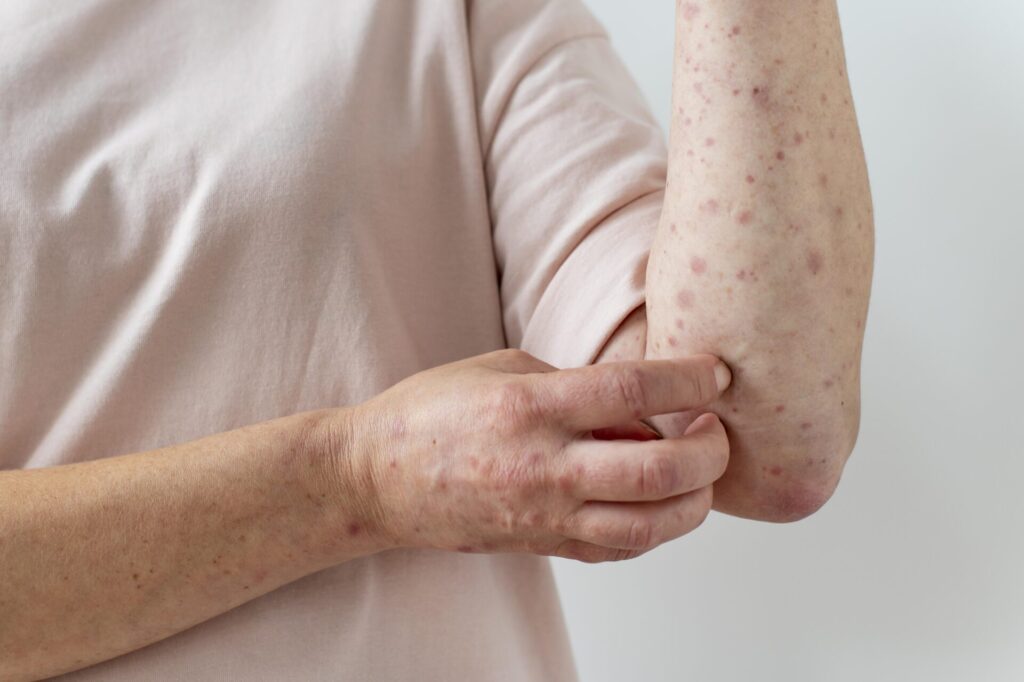Unraveling the Complexity of Psoriatic Arthritis: A Comprehensive Exploration
Contents
- 1 Unraveling the Complexity of Psoriatic Arthritis: A Comprehensive Exploration
- 2 Introduction
- 2.1 Types of Psoriatic Arthritis: Unveiling the Diversity
- 2.2 read more posts
- 2.3 Early Warning Signs: Navigating the Onset
- 2.4 Psoriatic Arthritis Nails: A Distinctive Aspect
- 2.5 read more posts
- 2.6 Joints Affected: Mapping the Impact
- 2.7 Causes and Risk Factors
- 2.8 Psoriatic arthritis risk factors include:
- 2.9 read more posts
- 2.10 Diagnosis
- 2.11 Treatment and Management
- 2.12 read more posts
- 2.13 Impact on Daily Life
- 2.14 Conclusion
- 2.15 read more posts
- 2.16 FAQs related to Psoriatic Arthritis
Read DISCLAIMER
Learn about the complexities of psoriatic arthritis, an inflammatory disease that combines psoriasis with joint inflammation. Examine its wide range of symptoms, methods of diagnosis, available treatments, and significant effects on day-to-day functioning.
Introduction

Psoriatic Arthritis (PsA) is a complex autoimmune disease that affects people with psoriasis and crosses the boundaries between dermatology and rheumatology. This comprehensive page covers the definition, kinds, symptoms, diagnosis, available treatments, and the significant influence that psoriatic arthritis has on the lives of individuals who are impacted in an effort to clarify the complex aspects of this condition.
Overview and Symptoms
People with psoriasis, an inflammatory illness marked by red, scaly patches on the skin, are most affected by psoriatic arthritis. But not everyone who has psoriasis goes on to get PsA. Joint inflammation brought on by this illness results in pain, stiffness, and edema. PsA symptoms can affect any area of the body, including the spine, fingers, toes, and other joints, and they can differ greatly from person to person.
Types of Psoriatic Arthritis: Unveiling the Diversity

1. Asymmetric Oligoarthritis:
– Involves inflammation in different joints on each side of the body.
2. Symmetric Polyarthritis:
– Similar to rheumatoid arthritis, affecting joints on both sides simultaneously.
3. Distal Interphalangeal Predominant (DIP):
– Primarily impacts the small joints of the fingers and toes.
4. Spondylitis:
– Affects the spine, leading to stiffness in the neck, lower back, and sacroiliac joints.
5. Arthritis Mutilans:
– Rare but severe, causing deformities and joint destruction.
read more posts
– Joint Pain and Stiffness:
– Particularly in the morning or after periods of inactivity.
– Swollen Fingers and Toes:
– Dactylitis, commonly known as “sausage fingers,” is a distinctive feature.
– Fatigue and Reduced Range of Motion:
– Persistent tiredness and limitations in joint movement.
Psoriatic Arthritis Nails: A Distinctive Aspect
– Pitting:
– Small dents or depressions on the surface of the nails.
– Discoloration:
– Changes in color, often yellow-brown.
– Separation:
– Nails may lift or separate from the nail bed.
read more posts
Joints Affected: Mapping the Impact
– Fingers and Toes:
– DIP joints and the entire finger or toe may be affected.
– Wrists and Ankles:
– Common sites for inflammation.
– Knees and Elbows:
– Synovitis can cause pain and swelling.
– Lower Back and Sacroiliac Joints:
– Spondylitis impacts the spine.
Causes and Risk Factors
It’s unclear exactly what causes psoriatic arthritis. It is thought to be an autoimmune illness, however, in which the body’s immune system unintentionally targets healthy tissues and cells, causing inflammation. It is thought that a combination of genetics, environmental factors, and an overactive immune system might lead to PsA.
Psoriatic arthritis risk factors include:
Having psoriasis: People who have psoriasis are more likely to have PsA.
Family history: The chance of having psoriasis or PsA is higher in families with a history of the disorder.
Age: Although it can appear at any age, psoriatic arthritis usually affects adults.
Gender: PsA can affect both men and women, however it affects males significantly more frequently.
read more posts
Diagnosis

Tests, physical examinations, and medical histories are frequently used in conjunction to diagnose psoriatic arthritis. The clinician who evaluates and diagnoses PsA is usually a rheumatologist, a specialist in arthritis and associated diseases. Possible diagnoses include:
A review of the patient’s symptoms and medical background, including any family history of arthritis or psoriasis
– Physical examination to look for skin anomalies, edema, and joint soreness
– Blood testing to determine inflammatory levels and rule out other types of arthritis
– Imaging procedures like MRIs, X-rays, or ultrasounds to look at the tissues and joints that are impacted
Treatment and Management

The goals of treating psoriatic arthritis are to control symptoms, shield the joints from harm, and enhance quality of life. A variety of drugs, dietary adjustments, and individualized therapy are frequently used in treatment regimens. Common therapies include of:
– Nonsteroidal anti-inflammatory medications (NSAIDs) to lessen inflammation and discomfort
– Drugs known as disease-modifying antirheumatics (DMARDs) to impede the course of illness
– Biologic medications that lower inflammation by targeting particular immune system components
– Exercise and physical treatment to increase flexibility and joint function
– Adjustments to one’s way of living, such as keeping a healthy weight and controlling stress
read more posts
Impact on Daily Life
An individual’s everyday life can be greatly impacted by having psoriatic arthritis. Mobility, productivity, and mental health can all be impacted by persistent pain, exhaustion, and tight joints. Support from family, friends, and medical experts may be necessary to manage the condition’s physical and psychological effects. Using symptom management techniques and modifying activities to account for limits can help people with PsA live happy, fulfilled lives in spite of its difficulties.
Research and Future Perspectives
Psoriatic arthritis is a condition that is being studied in order to better understand it, develop therapies for it, and improve the lives of those who have it. Future treatments for diseases like this might be more individualized and successful because to developments in precision medicine, targeted medications, and a better knowledge of the underlying causes of the illness.
Conclusion
The complicated interaction of autoimmune variables, joint inflammation, and skin manifestations in Psoriatic Arthritis (PsA) provides a unique tapestry of symptoms and difficulties for people who are afflicted. The variety of manifestations, ranging from uncommon arthritis mutilans to asymmetric oligoarthritis, highlights the variability of this illness.
The signs of PsA are as varied as the people who suffer from it, ranging from the noticeable alterations in nails to the effects on different joints throughout the body. The diagnosis, which frequently calls for a multidisciplinary approach, requires a thorough comprehension of the patient’s medical history, symptoms, and modern imaging methods.
Along with relieving symptoms, the treatment plan includes a variety of drugs, lifestyle modifications, and therapy modalities to minimize joint deterioration and enhance overall quality of life. But psoriatic arthritis has a far more significant effect on a person’s everyday life, mental health, and interpersonal connections than just their physical health.
Research initiatives provide a glimmer of hope as they work toward more specialized treatments and individualized strategies to better handle the complications of PsA. However, in order to improve the lives of individuals facing its problems, the path ahead calls for both scientific breakthroughs and a comprehensive comprehension of the complex nature of this illness.
read more posts
1. What is Psoriatic Arthritis?
An autoimmune condition known as psoriatic arthritis occurs when the body’s immune system unintentionally targets healthy skin and joints. People with psoriasis, a skin disorder characterized by red, scaly areas, frequently experience it. Over time, joint damage may result from mild to severe joint inflammation.
2. What are Types of Psoriatic Arthritis ?
Psoriatic arthritis manifests in different ways, and there are five main types:
– Asymmetric Oligoarthritis: Involves inflammation in different joints on each side of the body.
– Symmetric Polyarthritis: Similar to rheumatoid arthritis, affecting joints on both sides of the body simultaneously.
– Distal Interphalangeal Predominant (DIP): Primarily impacts the small joints of the fingers and toes.
– Spondylitis: Affects the spine and may cause stiffness in the neck, lower back, and sacroiliac joints.
– Arthritis Mutilans: Rare but severe, leading to deformities and joint destruction.
3. What are Early Warning Signs in Psoriatic Arthritis ?
Early detection is crucial. Watch for:
– Joint pain and stiffness, often in the morning.
– Swollen fingers and toes.
– Fatigue and reduced range of motion.
4. What are Diagnosing Psoriatic Arthritis ?
Diagnosis involves:
– Physical Examination: Assessing joints for swelling, tenderness, and range of motion.
– Imaging: X-rays and MRIs to detect joint damage.
– Blood Tests: Checking for inflammation markers like C-reactive protein (CRP) and rheumatoid factor.
5. What are Symptoms of Psoriatic Arthritis ?
Symptoms may vary but commonly include:
– Joint pain, swelling, and tenderness.
– Nail changes, such as pitting or ridges.
– Morning stiffness and fatigue.
6. What Psoriatic Arthritis Looks Like ?
– Psoriasis skin lesions.
– Swollen, red joints.
– Nail changes like pitting, discoloration, or separation.
7. What are Causes of Psoriatic Arthritis ?
While the exact cause is unclear, a combination of genetic and environmental factors is believed to trigger PsA. Family history and psoriasis diagnosis increase the risk.
8. How to Diagnose Psoriatic Arthritis?
A rheumatologist diagnoses PsA through a combination of clinical assessments, imaging, and blood tests. Early detection aids in effective management.
9. How to Treat Psoriatic Arthritis?
Treatment aims to control symptoms and prevent joint damage. Approaches include:
– Nonsteroidal Anti-Inflammatory Drugs (NSAIDs): To reduce pain and inflammation.
– Disease-Modifying Antirheumatic Drugs (DMARDs): Modifying the course of the disease.
– Biologics: Targeting specific immune responses.
– Physical Therapy: Improving joint function and mobility.
10. What are Psoriatic Arthritis Nails ?
Psoriatic arthritis can affect the nails, causing changes such as pitting, discoloration, or separation. Nail involvement often coexists with joint symptoms.
11. Which Joints are Affected in Psoriatic arthritis ?
Psoriatic arthritis commonly affects:
– Fingers and toes.
– Wrists and ankles.
– Knees and elbows.
– Lower back and sacroiliac joints.
12. Why Psoriatic Arthritis Is Painful?
It is due to:
– Inflammation in the joints and surrounding tissues.
– Potential joint damage leading to deformities.
– Chronic nature of the condition.
13. Is Psoriatic Arthritis hereditary?
Psoriatic Arthritis can have a genetic component. Having a family history of psoriasis or PsA increases the likelihood of developing the condition.
14. Can Psoriatic Arthritis be cured?
As of now, there is no cure for Psoriatic Arthritis. However, various treatments can effectively manage symptoms and improve quality of life.
15. Can Psoriatic Arthritis affect internal organs?
While PsA primarily impacts the joints and skin, it can also affect internal organs like the eyes (uveitis) or the gastrointestinal system in some cases.
16. How is Psoriatic Arthritis different from other types of arthritis?
Psoriatic Arthritis is distinct due to its association with psoriasis, its varied presentations affecting different joints, and its potential to cause nail changes.

Very interesting information!Perfect just what I was looking
for!?